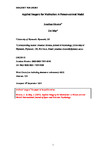Applied Imagery for Motivation: A Person-centred Model
| dc.contributor.author | Rhodes, J | |
| dc.contributor.author | May, Jon | |
| dc.date.accessioned | 2021-09-10T12:29:19Z | |
| dc.date.issued | 2021-10-11 | |
| dc.identifier.issn | 1557-251X | |
| dc.identifier.issn | 1557-251X | |
| dc.identifier.uri | http://hdl.handle.net/10026.1/17783 | |
| dc.description.abstract |
Motor imagery when coupled by motivational and cognitive factors have been shown to enhance multiple aspects for sports performance. This paper reviews existing imagery approaches, and proposes a method based on applied applications, intended to increase short and long-term motivation. Behavioural change is achieved by primarily using Motivational Interviewing (MI), then Functional Imagery Training (FIT), which has been adapted into the Applied Imagery for Motivation (AIM) model. AIM starts with an initial interview using MI, then has three imagery phases: macro imagery (beliefs, values and purposeful long-term goal), meso imagery (mentally contrasting between current and future self to evoke change), and micro imagery (planning for immediate action). We explain the use of these three stages which allow athletes to link everyday cues with imagery activation and immediate implementation action plans. We provide practitioners with a comprehensive applied guide to using AIM for performance, merging theory-driven established cognitive and motivational imagery approaches into structured practise. | |
| dc.format.extent | 1556-1575 | |
| dc.language | en | |
| dc.language.iso | en | |
| dc.publisher | Taylor & Francis (Routledge) | |
| dc.rights | Attribution-NonCommercial-NoDerivatives 4.0 International | |
| dc.rights | Attribution-NonCommercial-NoDerivatives 4.0 International | |
| dc.rights | Attribution-NonCommercial-NoDerivatives 4.0 International | |
| dc.rights.uri | http://creativecommons.org/licenses/by-nc-nd/4.0/ | |
| dc.rights.uri | http://creativecommons.org/licenses/by-nc-nd/4.0/ | |
| dc.rights.uri | http://creativecommons.org/licenses/by-nc-nd/4.0/ | |
| dc.subject | Applied imagery for motivation | |
| dc.subject | functional imagery training | |
| dc.subject | motivational interviewing | |
| dc.subject | imagery | |
| dc.subject | sport | |
| dc.title | Applied Imagery for Motivation: A Person-centred Model | |
| dc.type | journal-article | |
| dc.type | Journal Article | |
| plymouth.author-url | https://www.webofscience.com/api/gateway?GWVersion=2&SrcApp=PARTNER_APP&SrcAuth=LinksAMR&KeyUT=WOS:000706276400001&DestLinkType=FullRecord&DestApp=ALL_WOS&UsrCustomerID=11bb513d99f797142bcfeffcc58ea008 | |
| plymouth.issue | 6 | |
| plymouth.volume | 20 | |
| plymouth.publication-status | Published | |
| plymouth.journal | International Journal of Sport and Exercise Psychology | |
| dc.identifier.doi | 10.1080/1612197X.2021.1987959 | |
| plymouth.organisational-group | /Plymouth | |
| plymouth.organisational-group | /Plymouth/Faculty of Health | |
| plymouth.organisational-group | /Plymouth/REF 2021 Researchers by UoA | |
| plymouth.organisational-group | /Plymouth/REF 2021 Researchers by UoA/UoA04 Psychology, Psychiatry and Neuroscience | |
| plymouth.organisational-group | /Plymouth/REF 2021 Researchers by UoA/UoA04 Psychology, Psychiatry and Neuroscience/UoA04 REF peer reviewers | |
| plymouth.organisational-group | /Plymouth/Research Groups | |
| plymouth.organisational-group | /Plymouth/Research Groups/Centre for Brain, Cognition and Behaviour (CBCB) | |
| plymouth.organisational-group | /Plymouth/Research Groups/Centre for Brain, Cognition and Behaviour (CBCB)/Behaviour | |
| plymouth.organisational-group | /Plymouth/Research Groups/Institute of Health and Community | |
| plymouth.organisational-group | /Plymouth/Users by role | |
| plymouth.organisational-group | /Plymouth/Users by role/Academics | |
| dcterms.dateAccepted | 2021-09-09 | |
| dc.rights.embargodate | 2021-10-16 | |
| dc.identifier.eissn | 1557-251X | |
| dc.rights.embargoperiod | Not known | |
| rioxxterms.versionofrecord | 10.1080/1612197X.2021.1987959 | |
| rioxxterms.licenseref.uri | http://creativecommons.org/licenses/by-nc-nd/4.0/ | |
| rioxxterms.licenseref.startdate | 2021-10-11 | |
| rioxxterms.type | Journal Article/Review |



